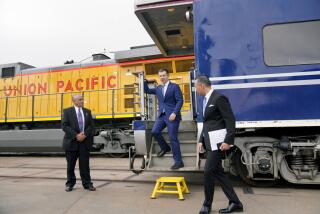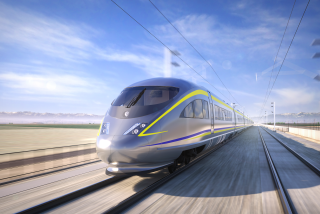Gov.’s Plan Is a Boon to Area Rail
Gov. Arnold Schwarzenegger’s $222-billion infrastructure improvement plan for California has the potential to transform the region’s antiquated rail system, which has become increasingly congested with freight and passenger traffic.
Southern California’s railways remain a relic of the pre-World War II era even as the region has become one of the world’s top gateways for goods in the 21st century.
With rail space at a premium, freight carriers compete for time with burgeoning commuter rail lines -- an arrangement that has left the Southland’s Metrolink system struggling to keep its trains on time.
Officials estimate that rail traffic will increase more than 40% in the next decade, creating more-severe congestion.
Although the governor’s freeway improvement proposals have garnered the most attention, transportation experts say his ideas about rail expansion might have a much greater effect on Southern California in terms of transit and the economy.
The governor’s proposal calls for spending billions of dollars on rail line improvements, such as adding tracks, creating grade separations -- overpasses or underpasses to keep train and auto traffic separate -- at dozens of rail crossings, and expanding cargo-loading facilities in an effort to speed up trains.
The goal, administration officials say, is to encourage more use of freight trains to help clear freeways of cargo-carrying trucks -- and, it is hoped, reduce diesel pollution.
“The freeways are already too congested, and so part of the governor’s strategic growth plan is for capital investments,” said Sunne Wright McPeak, Schwarzenegger’s secretary for business, transportation and housing.
The governor’s plan is generating excitement in rail and commerce circles, with officials saying it has the potential to make significant improvements in the movement of goods.
But some Democratic legislators believe some of the financial details are too optimistic. Some leaders of the Legislature last week said they wanted to scale down the infrastructure plan.
Furthermore, communities along rail lines worry about the noise and pollution that would come with more trains.
In the city of Commerce, officials say residents suffer health problems from truck and train shipping centers in and around the community. Three years ago, an out-of-control freight train derailed in a residential area, flattening several homes.
“We suffer the impacts of overflow.... We’ve seen increased incidents of cancer, asthma, bronchitis and learning disabilities,” said Councilwoman Nancy Ramos, who calls herself a “second-generation asthmatic” whose children and grandchildren are now “third- and fourth-generation asthmatics.”
“We are against rail expansion,” she said.
*
Hundreds of steel boxes packed with tennis shoes from Malaysia, dolls from Indonesia and electronics from China cover nearly every square inch of the 243-acre Hobart train yard just south of downtown Los Angeles.
Hard-hatted workers in two-story mechanical lifts operate metal arms with claw-like steel fingers that grab the containers and place them on freight cars bound for cities across the nation.
But with more and more cargo from the ports of Los Angeles and Long Beach arriving around the clock, the mechanical lifts and 8,000-foot trains sometimes have a hard time keeping up.
Today the Los Angeles-Long Beach seaport complex is the fifth-busiest in the world, after booming ports in Asia, including Hong Kong and Singapore. Container traffic, which more than doubled in the last decade, is expected to nearly triple in the next 15 years.
To keep up, about 114 freight trains now roll across the region on mainline railroad tracks, shared with 70 commuter trains, every day. By 2010, train traffic is expected to grow by 44%, to about 165 cargo and 100 passenger trains a day, according to the Southern California Assn. of Governments. If nothing is done by then, tracks could get so backed up that each train would take an extra three hours and 20 minutes to crawl through the region.
By 2025, rail traffic is expected to grow 47% more, to nearly 390 trains a day.
The growth in train traffic alarms experts because of potential ripple effects: Delays along rail lines increase the cost of hauling freight, which could cause companies to switch to trucks -- further clogging freeways and polluting the air with toxic exhaust fumes.
The Southland also depends on a healthy freight transport system for its employment base, economists say. An estimated 550,000 jobs in the region are directly or indirectly associated with trade and transportation activities stemming from the twin ports, which saw trade volumes more than double over the last decade, according to the Los Angeles Economic Development Corp. Planners and economists say trade volume could triple in the next 20 years.
Schwarzenegger’s plan, now being considered by the Legislature, is the biggest of several efforts in recent years to improve Southern California’s rail system.
Until now, the biggest project was the $2.5-billion Alameda Corridor, a freight train superhighway opened in 2002 that runs 20 miles from the ports to near downtown Los Angeles.
The region’s two major railroads -- Burlington Northern Santa Fe and Union Pacific -- are in the midst of their own infrastructure expansions.
Burlington Northern is planning to build a new rail yard in Long Beach to handle the increasing volume of freight from overseas.
The company also is building a third set of tracks through the Cajon Pass in San Bernardino County, a key corridor between the San Gabriel and San Bernardino mountains. Yet planners say the congested pass already could use quadruple tracks, and they predict it will need a fifth set of tracks by 2010.
Union Pacific is double-tracking portions of its mainline route in the region, including congested areas of Pomona, in east Los Angeles County, and Fontana, in San Bernardino County.
Despite these projects, railroad representatives and transportation experts say the system is still in dire need of help.
In Colton in San Bernardino County, Union Pacific and Burlington Northern tracks intersect at a 90-degree angle -- which means trains sometimes have to wait for each other to cross.
The Colton crossing “is a major element in slowing down all the freight in Southern California,” said John Husing, a consultant to SCAG. “The whole rail system in Southern California is reaching capacity. The tracks are overwhelmed.”
The rising freight traffic is also causing problems for Metrolink, which runs about 40 trains a day between downtown Los Angeles and outlying suburbs.
“We’d like to go up to 56 trains by 2010,” said David Solow, chief executive of the commuter rail service that serves L.A., Orange, Riverside, San Bernardino and Ventura counties. “It’s a struggle. I can’t add any more trains without more track investment.”
Metrolink leases nearly half of its 400-mile track system from Union Pacific and Burlington Northern. And their track-sharing arrangement has become increasingly tense.
On a recent morning, Metrolink canceled train No. 401 on its Riverside Line after freight cars blocked its path, delaying about 180 passengers for an hour.
The next day, the same commuter train was delayed 28 minutes, again because of conflicts with freight haulers.
Schwarzenegger’s plan would eliminate some street-level crossings and would extend existing tracks around Union Station, allowing trains to move in and out of the depot more freely and without having to reverse directions. The governor also proposes triple-tracking an eight-mile stretch east of downtown to reduce congestion caused by passenger trains sharing tracks with freight trains serving the two ports.
The governor also wants the state to borrow $3 billion over the next decade to upgrade the region’s freight transport system. The state would provide 20% in seed money, while the private sector and other public sources would contribute the remainder.
But critics question whether the private sector will be able to come up with its share of the 80% to cover some of the projects. They also chafe at Schwarzenegger’s plan to have state officials, rather than local agencies, determine which projects receive funding.
“We tried that approach in the past with the [Gov. Gray] Davis administration, and I don’t think it worked very well,” said Assemblywoman Jenny Oropeza (D-Long Beach), chairwoman of the body’s transportation committee.
Oropeza said that instead of earmarking specific projects, the governor should make available a pool of money and allow local transportation officials to determine how best to use it.
On this much, many experts agree: Increasing the use of rail is one of the region’s best and quickest hopes for reducing freeway congestion and improving air quality.
The average freight train, with about 280 cars, takes an equivalent number of trucks off freeways and environmentally is three to four times cleaner, experts say.
Also, expanding the freeway network, such as building toll lanes for trucks, could take a decade or more to complete. In contrast, major rail improvement projects could be done in a few years -- a much quicker fix for the region’s transportation woes and clean air needs.
“The governor’s plan is a good step forward,” said Hasan Ikhrata, director of transportation policy and planning for the Southern California Assn. of Governments. “Something has to be done, and done fast, to keep this region competitive. Now the private sector has to step to the table.”
More to Read
Sign up for Essential California
The most important California stories and recommendations in your inbox every morning.
You may occasionally receive promotional content from the Los Angeles Times.










